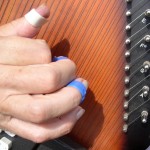I hurt my finger on vacation. A marble bathroom sink top fell and tore off the top of my left hand ring finger (though not completely off…the ER doctor was happy my fingertip was “still attached”).
It took four stitches to hold my finger together. They just got removed this week. I can do most everything right now…
…except play the guitar.
If you are a music therapist, or music therapy student, I think I just heard you groan. Yes, I cannot play my guitar right now. Which sucks, because I use my guitar EVERY DAY at work.
I don’t yet know when I will be able to play my guitar. But that’s okay, because I will be using my autoharp, inst ead.
ead.
Remember the autoharp? Remember sitting with your elementary school music teacher, the autoharp sitting on the floor in front of you? You would press on the white chord button with your left hand, then cross your right hand over your left and strum with a pick. Voila! Instant music.
The autoharp is actually a very useful instrument for a music therapist, for several reasons:
- It is very portable.
- It is easy to play. Just press a button and strum.
- The chords can sound richer than guitar chords because you have so many strings at your disposal.
- The range is extensive. You can easily play full chords using all the strings, high chords using the upper strings, or low chords using the lower strings.
- You can easily play a variety of dynamic changes based on how you strum.
Now, to be fair, there are a couple of downsides to the autoharp:
- It can be a pain to tune. (On the flip side, once you are used to tuning, it only takes about 5-10 minutes. And you only need to tune it as needed, which means you can go months without a tune-up.)
- If you’re used to playing songs on the guitar, it will have to practice the songs on the autoharp (unless, of course, you know the chords. But, if you are like me, the muscle memory in my hands know the guitar chords, which does not transfer easily to the autoharp. Thus, I will be practicing).
- You have to learn how to pick on the authoharp. A much easier task on the six-string guitar than on the 30+ string autoharp.
So, for the forseeable future, I will be dusting off my autoharp and re-practicing the songs I know. Who knows…maybe it’s time for you to dust off yours, too.


 orcid.org/0000-0001-8665-1493
orcid.org/0000-0001-8665-1493






{ 8 comments… read them below or add one }
Thank you, Roia. It seems to me that we are both using instruments that work best with our different populations. The autoharp has been great for me as I work on self-regulation and sensorimotor goals, but might not be the most appropriate instrument for the goals you are addressing. I guess it’s good us music therapists have lots of instruments to choose from!
Kimberly
bathroom sinks that are made from ceramics are always the best choice. they last longer and very strong”;’
well, our bathroom sink is always made from stainless steel because they are long lasting ,-*
I don’t believe that most people know the autoharp well enough to appreciate them. They are great for playing rhythm or melody and a great accompaniment to singing. I now play one, along with various instruments. I have four autoharps and another on the way (got three from ebay) and I love to play them! I have witnessed them played in hospitals, schools, and nursing homes, as well as on stage, and almost everyone loves the music that they produce! I would think that it’s the perfect instrument for music therapy. I hope that the finger is all healed up! Keep on harpin’!
Glad to read this, not so glad about your poor finger which I hope is all healed up now!!
I’m also a music therapist, and I’ve hurt my left elbow, and playing the guitar seems to be hindering its healing. I was thinking of buying an autoharp, but that’s been easier said than done. I also came across some videos about using the QChord with the client and therapist playing together, which I like. Do you think one may be better for that purpose than the other? The QChord has more functions than I need (I need just a chord accompaniment!) but it might be fun to explore those. As far as a client doing the strumming portion it would seem to me that the strings are a nicer option for the tactile feel. Decisions, decisions… lol Your thoughts?
I definitely think there is a place for both. I have some experience with a Qchord, but like you mentioned, I like the tactile quality the autoharp provides. Plus, in general, I prefer an acoustic sound when possible. That said, if I had a lot of clients with significant physical challenges, the Qchord would be a very nice option as they could easily make quality music and could have a level of instantaneous feedback. Hope this helps! ~Kimberly
My aunt used to have an autoharp and I was always intrigued by it. But yes, a total pain to tune!
Kimberly I totally hear you. I actually injured my elbow last year and things have been sore ever since. At the moment, playing worship chords on my guitar is okay unless I want to strum. That’s where the challenge is. Still working on things, but I’d never considered the autoharp. I’m looking them up now thanks for the rec!
– Christy
You must log in to post a comment.